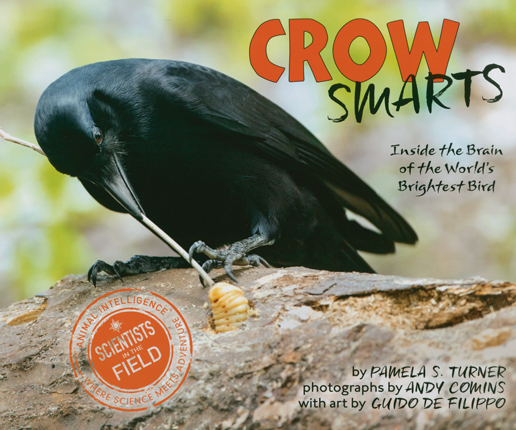Full Text Reviews: Bulletin for the Center... - 09/01/2016 The Scientists in the Field series heads south to follow the work of Gavin Hunt, who studies crow intelligence on the South Sea island of New Caledonia; author Turner joins scientist Hunt to witness the tool-using, problem-solving behavior of the New Caledonian crows. Unique in the bird world, the New Caledonian crows adapt twigs into useful shapes for pulling grubs out of trees, and Turner watches a crow parent attempting to teach a young crow this important skill. She also visits a research facility that tests the local crows’ problem-solving abilities (and scores them against elementary-school-aged human children). Turner’s voice has a quippy irreverence that occasionally tilts too far to the flippant but is often pretty amusing, especially in her absorbing explanation of of crow family dynamics; the book also pulls together a wide variety of research on crow behaviors and weaves it seamlessly into the narrative. Detailed sidebars and lively photographs of shiny, bright-eyed crows break up the text while adding interest, and illustrated explanations of crow behavior are illuminating. End matter includes an index, a lively Q&A with the author, who participates in wild bird rescue in the U.S., and an erudite bibliography of mostly academic publications. DS - Copyright 2016 The Board of Trustees of the University of Illinois. School Library Journal - 08/01/2016 Gr 4–7—This title takes readers to New Caledonia, where, as Turner puts it, "the forests are lush and the crows are geniuses." Comins's photos supply ample evidence of both. Under the guidance of crow researcher Gavin Hunt, expeditions to the island's wilds provide opportunities to watch the local species of crow display the astonishing ability not only to use found sticks to dig grubs from logs but also to make their own hooked tools from twigs or the jagged leaves of the pandanus—and to train a juvenile crow in the technique. Then later, under controlled conditions in a lab, captive crows (which are carefully returned to their home territories afterward) beat out groups of four- to seven-year-old children in performing feats of mental activity to get at an inaccessible treat. The author also surveys tool use by other wild animals, from chimps to crocodiles, and, with added art by de Filippo, compares the structures of crow and human brains. She closes with more anecdotes about corvid intelligence and leads to further information. VERDICT Required reading for anyone who believes that we are the only, or even the most, sapient species on the planet. Highly recommended for STEM and animal collections.—John Peters, Children's Literature Consultant, New York City - Copyright 2016 Publishers Weekly, Library Journal and/or School Library Journal used with permission. Loading...
|




